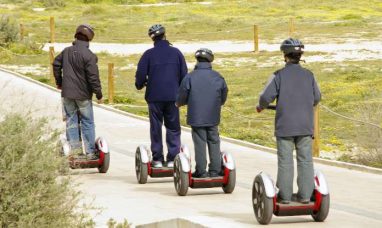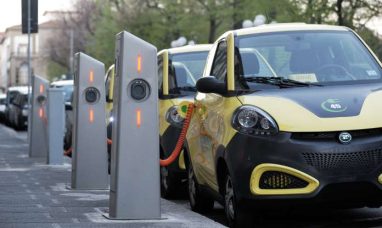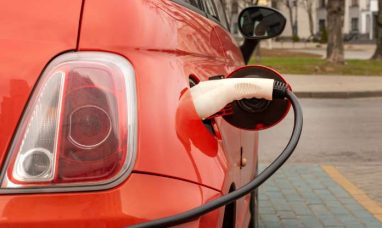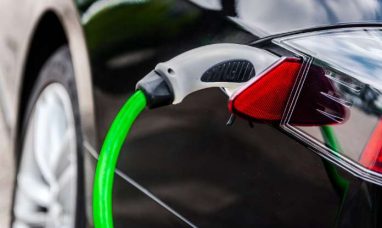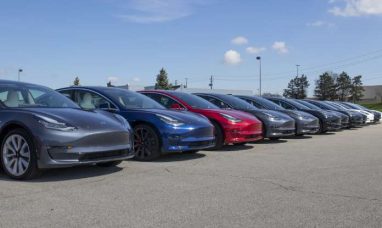DUBLIN, Aug. 15, 2023 /PRNewswire/ — The “China Automotive Fragrance and Air Purification Systems Research Report, 2023” report has been added to ResearchAndMarkets.com’s offering.

In the passenger car market, the fragrance and air purification systems boom
The fragrance system has developed from the initial ‘perfume bottle + negative ion generator’ to independent intelligent fragrance system; in some models, the air purification system is integrated with the air filter to constitute a complete automotive air management system, and also packs comprehensive air management technologies such as advanced filter elements (dual-effect element, HEPA element, etc.), air quality system (AQS), and air purification system (e.g., negative ion generator and UV generation device).
Rapid growth in 2023: The automotive fragrance installation will exceed 1 million units, and the air purification system installation will surpass 6 million units.
From 2020 to 2023, the installations of automotive air purification and fragrance systems will sustain steady growth. It is predicted that in 2023 the installations of automotive air purification systems will exceed 6 million units, and that of fragrance systems will reach 1.03 million units.
Overall the air purification system is mainly a standard component of passenger cars. The installation of standard fragrance systems began to surge in 2022, and is expected to reach 582,700 units in 2023, exceeding the optional for the first time.
Suppliers: Explore new air purification technologies and develop vehicle air management solutions
Air purification and fragrance systems are generally integrated into the functional module of air conditioning systems, and the main suppliers are as follows:
Denso
In 2022, Denso introduced AiO BOX, an air quality solution that fully integrates all air purification system components and uses the unique airflow cleaning technology. With a plasma generator and double electrodes, it can release positive and negative ions simultaneously at the front and rear air outlets. The high integration of PM2.5 sensor and HVAC enables fanless air filtration.
The simple version of AiO BOX equipped with plasma generator, PM2.5 sensor and CN95 filter was mass-produced in late 2022. Denso plans volume production of the complete version of AiO BOX equipped with evaporator cleaning system and intelligent fragrance unit in 2024.
Sailing Technology
Sailing Automotive Electronics (Taizhou) Co., Ltd. provides complete air system solutions for OEMs. During 2022-2027, the company plans to produce a total of about 34.11 million designated products, including more than 12.77 million PM2.5 filters, more than 7.4 million negative ion generators, more than 12.78 million fragrance systems and more than 1.16 million AQS systems. By the end of 2022, some of the designated products have started to be delivered to automakers. For example, Sailing Technology has already provided fragrance systems for Li L9 and XPeng G9.
Sailing Technology provides Toyota with a customized negative ion fragrance system, with the concentration adjusted via WeChat applet and the center console screen. This system is applicable to models like Sienna, Venza, Highlander and Frontlander, with the fragrance bottle placed in the glove box.
OEMs: Upgrade air purification system functions, and emerging OEMs prefer intelligent fragrance systems.
Since 2020, mainstream models have offered upgrading air purification system functions. Some automakers (e.g. Geely and WM Motor) have passed the CN95 certification for their air filters. International OEMs are cooperating with air purification system integrators like Valeo and MAHLE to add an air quality manager (AQS) and negative ion/plasma technology to their original air purification systems, aiming to further improve the pollutant filtration efficiency of their existing air purification systems.
Chinese emerging OEMs (NIO, Li Auto, XPeng Motor, AITO, etc.) boast a higher installation rate of fragrance systems, and prefer intelligent fragrance systems. Their fragrance suppliers are international groups (Givaudan, Symrise, IFF, Firmenich, etc.). Most conventional international OEMs (Mercedes-Benz, BMW, etc.) adopt non-intelligent fragrance system designs.
At present, some Chinese OEMs have the ability to independently develop intelligent fragrance technologies, especially human feature recognition and monitoring, and fragrance system intelligent control (automatic opening / intelligent fragrance delivery / automatic fragrance switching / voice control).
NIO intelligent fragrance system
All of NIO’s models carry an intelligent fragrance system, which is connected to the IVI system and can be turned on independently. Its fragrance bottle is equipped with magnetic suction technology and NFC chip for fast recognition. The system is designed by Shanghai ARTOP Industrial Design Co., Ltd.
Mercedes-Benz fragrance system
Mercedes-Benz was the first OEM to introduce fragrance systems, which is installed in C-Class (AMG Models), GLS, CLS, S-Class, GLE, E-Class, G-Class and other models. Provided by the international fragrance group Symrise, the fragrance for S-Class is integrated with the Mercedes-Benz Air Balance system that offers the negative ion air purification function.
Geely IAPS (Intelligent Air Purification System)
Based on the original air conditioner filter, Geely’s intelligent air purification system (IAPS) adopts the architecture of ‘AQS + PM2.5 four-layer air purification device + negative ion generator’, which can efficiently filter conventional dusts, harmful gases, PM2.5 particles, >0.74µm droplets, and >0.3µm particles.
Key Topics Covered:
1 Overview of Fragrance and Air Purification Systems
1.1 Overview of Fragrance System
1.1.1 Development History of Fragrance System
1.1.2 Principle of Fragrance System
1.1.3 Structure of Fragrance System
1.1.4 Fragrance Control System: Control Principle of Encryption Chip
1.1.5 Fragrance System Technology
1.1.5.2 NFC Chip Recognition
1.1.5.2 Magnetic Suction/Scenario Linkage Mode (2)
1.1.6 Fragrance Materials and Suppliers
1.2 Air Purification Technology
1.2.1 Development History of Air Purification System
1.2.2 Principle of Air Purification System: Sources of Pollution and Conventional Purification Process
1.2.3 Structure of Air Purification System
1.2.3.1 High-efficiency Air Purification Process
1.2.3.2 Purification Characteristics
1.2.4 Major Air Purification Technologies:
1.2.4.1 Negative Ion/Plasma System
1.2.4.2 Ultraviolet Light
1.2.4.3 Photocatalyst
1.2.5 Air Filter Technologies
1.2.5.1 AQS Monitoring / Physisorption
1.2.5.2 Filter Element/HEPA Filter Mesh
1.2.6 Other Air Purification Component: Ultrasonic Atomizer
2 Fragrance and Air Purification Systems Market
2.1 Industry Regulations and Certification
2.1.1 Industry Regulation: ‘Guideline for Air Quality Assessment of Passenger Car
2.1.2 CN95 Filter Certification, 2020-2022
2.1.3 Automotive CN95 Certification, 2020-2022
2.2 Market Data
2.2.1 Installations of Fragrance and Air Purification Systems, 2020-2023
2.2.2 Price Range of Models Installed with Fragrance and Air Purification Systems, 2021-2022
2.2.3 Power Type of Models Installed with Fragrance and Air Purification Systems, 2020-2022
2.2.4 TOP 20 Passenger Car Models with Air Purification System and Fragrance Systems in China, 2022
2.2.4.1 Mercedes-Benz’s Installation Rate of Fragrance and Air Purification Systems, 2020-2022
2.2.4.2 BMW’s Installation Rate of Fragrance and Air Purification Systems, 2020-2022
2.2.4.3 Audi’s Installation Rate of Fragrance and Air Purification Systems, 2020-2022
2.2.4.4 Chery’s Installation Rate of Fragrance and Air Purification Systems, 2020-2022
2.2.4.5 BYD’s Installation Rate of Fragrance and Air Purification Systems, 2020-2022
2.2.4.6 Geely’s Installation Rate of Fragrance and Air Purification Systems, 2020-2022
2.2.4.7 GAC Aion’s Installation Rate of Fragrance and Air Purification Systems, 2020-2022
2.2.4.8 Toyota’s Installation Rate of Fragrance and Air Purification Systems, 2020-2022
2.2.4.9 Volkswagen’s Installation Rate of Fragrance and Air Purification Systems, 2020-2022
2.2.4.10 Emerging Automakers’ Installation Rate of Fragrance and Air Purification Systems, 2020-2022
2.2.4.11 Industry Chain of Fragrance and Air Purification Systems
3 Fragrance and Air Purification Systems Manufacturers
3.1 Valeo
3.2 Denso
3.3 MAHLE
3.4 Hanon
3.5 Freudenberg
3.6 Sailing Technology
3.7 CUBIC
3.8 Goldensea Hi-Tech
3.9 Dongjian Technology
3.10 Desay SV3.11 PATEO CONNECT+
3.12 Sunlord Electronics: Fragrance Control System
3.13 ST
4 Fragrance and Air Purification System Cases of OEMs
4.1 Tesla’s Air Purification System
- Self-developed Fragrance System Technologies of OEMs
- Comparison of Parameters of Fragrance Systems between Models of OEMs
- Comparison of Parameters of Air Purification Systems between Models of OEMs
4.2 Li Auto’s Fragrance and Air Purification Systems
4.3 NIO’s Fragrance and Air Purification Systems
4.3.1 Intelligent Fragrance System
4.3.2 Air Purification System
4.4 XPeng’s Fragrance and Air Purification Systems
4.5 BYD’s Fragrance and Air Purification Systems
4.5.1 DiLink System
4.5.2 Fragrance System
4.6 AITO’s Fragrance and Air Purification Systems
4.7.1 SAIC IM’s Fragrance System
4.7.2 SAIC IM’s Air Purification System
4.8 Mercedes-Benz’s Air Balance System
4.9 BMW’s Fragrance and Air Purification Systems
4.9.1 Negative Ion Fragrance System for BMW Models
4.9.2 Air Purification System
4.10 SAIC Audi’s Fragrance and Air Purification Systems
4.11.1 Geely’s Fragrance System
4.11.2 Geely’s Intelligent Air Purification System (IAPS)
4.12 Volvo CLEANZONE
4.13 Chery’s Air Filtration System
4.14 Toyota’s Nanoe Air Purification System
4.15 Changan Forest Air Purification System
4.16 Renault’s Fragrance and Air Purification Systems
4.17 SAIC Roewe’s UV Sterilization System
4.18 HiPhi’s Fragrance and Air Purification Systems
4.19 GAC Aion’s Intelligent Health Cockpit
4.20 Weltmeister EX6 Plus 6: CleanPro Healthy Cabin
For more information about this report visit https://www.researchandmarkets.com/r/ujzmw0
About ResearchAndMarkets.com
ResearchAndMarkets.com is the world’s leading source for international market research reports and market data. We provide you with the latest data on international and regional markets, key industries, the top companies, new products and the latest trends.
Media Contact:
Research and Markets
Laura Wood, Senior Manager
[email protected]
For E.S.T Office Hours Call +1-917-300-0470
For U.S./CAN Toll Free Call +1-800-526-8630
For GMT Office Hours Call +353-1-416-8900
U.S. Fax: 646-607-1907
Fax (outside U.S.): +353-1-481-1716
Logo: https://mma.prnewswire.com/media/539438/Research_and_Markets_Logo.jpg
SOURCE Research and Markets

Featured image: I Stock © CHUNYIP WONG..









